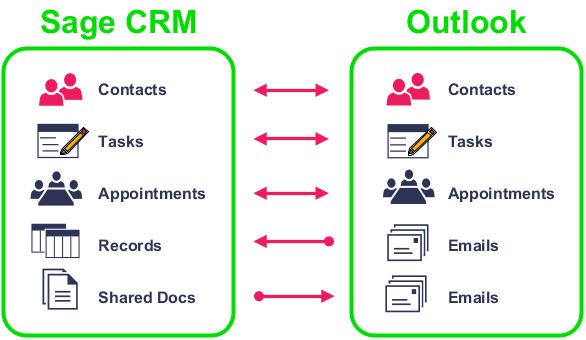About Classic Outlook Integration
Classic Outlook Integration files emails, and synchronizes contacts, appointments, and tasks between Sage CRM and Microsoft Outlook. It lets users file single or multiple Outlook emails to one or more Sage CRM records, and attach Sage CRM shared documents to Outlook emails. Sage CRM Classic Outlook Integration supports email accounts running on Microsoft Exchange Server MAPI or POP3. Roaming Profiles are not supported.
The first synchronization synchronizes:
- Recurring appointments.
- Appointments which have been modified in the last 14 days.
- Appointments with an end date between the last 14 days and today.
- Tasks which have been modified in the last 14 days.
- Tasks with a status of Pending or In Progress.
- Any flagged Sage CRM contacts, or contacts that have been added to the Contacts tab in Outlook.
Subsequent synchronizations synchronize:
- Appointments modified since the last synchronization.
- Tasks modified since the last synchronization.
- Any new, updated, or deleted flagged Sage CRM contacts, or any new, updated, or deleted contacts on the Contacts tab in Outlook. If a synchronized Sage CRM contact shares an address with another person or company, and you change the address in Outlook, Sage CRM updates the shared address with the new information during Contact synchronization.
How to enable Classic Outlook Integration
In order to use Classic Outlook Integration, a user must download and install a plugin on the client machine. The plugin works on a 32-bit machine only. As a system administrator, you can display or hide the button that allows users to install the plugin.
|
Task |
Help |
|---|---|
|
Specify Sage CRM time zone settings. Incorrect time zone settings can prevent Sage CRM contacts synching to Outlook. |
|
|
Display the Install Classic Outlook Integration button for a specific user. |
|
|
If you're using Sage CRM over HTTPS, or you're using a non-standard port, you might need to change the default port used by the Classic Outlook Plugin installer. |
How to set up synchronization
|
Task |
Help |
|---|---|
|
Select the direction in which data is synchronized between Outlook and Sage CRM. |
|
|
Enable synchronization of contacts, appointments, and tasks. |
|
|
Prevent synchronization to Outlook for specific Sage CRM records if necessary. |
|
|
Decide what happens to appointments, tasks, and contacts in Sage CRM when they're deleted in Outlook. |
|
|
Specify how to manage synchronization conflicts. |
|
|
Configure how often automatic synchronization occurs. |
|
|
Enable logging for Classic Outlook Integration so users can view and resolve synchronization errors. |
How data is mapped between Sage CRM and Outlook
|
Task |
Help |
|---|---|
|
Review how contacts are mapped between Sage CRM and Outlook and change the mappings if necessary. |
|
|
You can use data upload to import a large number of contacts from Outlook to Sage CRM. |
|
|
Review how appointments are mapped between Sage CRM and Outlook and change the mappings if necessary. |
|
|
Review how tasks are mapped between Sage CRM and Outlook and change the mappings if necessary. |
|
|
Review how tasks statuses are mapped between Sage CRM and Outlook and change the mappings if necessary. |
|
|
You can customize the details that are added to tasks and appointments sent from Sage CRM to Outlook. |
Classic Outlook Integration licenses
The Classic Outlook Plugin uses Sage CRM concurrent licenses as follows:
- If a user is filing emails or adding contacts in Outlook using the plugin, one seat of a concurrent license is used.
- If a user is filing emails or adding contacts in Outlook using the plugin, and is also logged on to Sage CRM using a browser, one seat of a concurrent license is used.
- If a user is filing emails or adding contacts in Outlook using the plugin, and a second user is logged on to Sage CRM using a browser, two seats of a concurrent license are used.
- The license is freed up when Outlook closes or the Sage CRM session expires. Where a user is using the plugin in Outlook and using Sage CRM in a browser, the license is freed only when both Outlook and the Sage CRM session close. The license is not freed when the user action (synching, or filing an email) completes.

